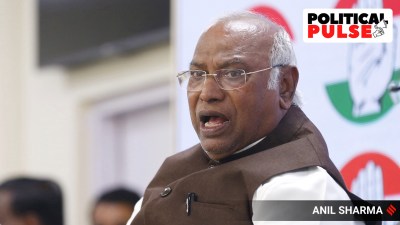- India
- International
The Precarity of Dalit Lives in India
Atrocities on Dalits are never a singular instance, they are part of a larger narrative of caste vengeance and a reflection of a hurt savarna pride.
 Rape is used as an instrument of stamping the authority of men over women. If patriarchy operates through various socio-cultural norms, then rape is a weapon of the humiliation of the body and self.
Rape is used as an instrument of stamping the authority of men over women. If patriarchy operates through various socio-cultural norms, then rape is a weapon of the humiliation of the body and self.Written by Javed Iqbal Wani and L David Lal
On September 30, in the dark of night, a young Dalit girl was cremated in an undignified manner by the Uttar Pradesh police. The police did not allow the family and relatives of the girl to attend the funeral. In the development of the case up to now, the focus has primarily remained on the perpetrators of violence. We contend that in addition to the four alleged perpetrators, the investigation agencies must not ignore the complicity of the police and the state administration in the process. The UP administration, it is becoming clear, is an accomplice to the crime and has openly violated due process, both legal and moral.
The 19-year-old girl from Valmiki community, it is alleged, died of rape and torture at the hands of four upper-caste men who belonged to the Thakur community. She went to cut grass in the fields in Boolagarhi village of Hathras, when the upper caste men found her and allegedly raped her on September 14.
The narrative of savagery that appeared in the reports following the incident highlights that the assault did not merely exhibit the desire for a feminine body but used to display caste dominance. According to the latest Crime in India Report, six Scheduled Caste women are raped in India every day. The Haters case is distinct because of the vulgar display of state collusion with the perpetrators of caste violence.
The brutal assault on the girl in Hathras indicates that though the punishments have got harsher for caste atrocities and sexual assault, the perpetrators now not only rape and assault but aim to kill or maim the victim to avoid any indictment later. The condition in which the girl was found in the fields by her mother points out that the assaulters had left her for dead. Second, had the girl not been brought and later died in a top medical institute in the national capital, the case would not have become common knowledge and remained just another case of forgotten caste and sexual violence. Third, despite parallel narratives created to discredit the allegation of rape on the accused, the victim had made a video statement before her death which was widely circulated on the internet. Fourth, a midnight cremation of the victim’s body raised new questions and exposed various loopholes in the entire story.

The police administration of the state, particularly the ADGP, peddled a misinformed narrative that the victim was not even raped because there was no semen found in the medical report. However, later it came to light that the sample sent for examination was eleven days old and the victim had told the doctor that complete penetration had taken place during the sexual assault. The ADGP wilfully ignored that in 2013 after the horrific Nirbhaya case, IPC section 375 had ruled out ‘no sperm-no rape’ argument and stated that penetration is sufficient to constitute the sexual intercourse necessary to the offence of rape. The initial report of gang rape that caused multiple life-threatening injuries to the victim is also now being questioned. However, the ‘burden of proof’ in the cases related to the absence of consent in rape now lies upon the accused and not the victim.
The force of Brahmanical patriarchy appears to be more powerful than that of the state. It is the parallel rules and laws of caste that decide the fate of the marginalised Scheduled Castes. As per various news reports, Thakurs of nearby villages had held a caste panchayat vowing protection to the accused and threats to the Dalit community in the village. Brahmanical patriarchy emerges as a counter-sovereign that neither recognises nor respects the rule of law or constitutional rights. It only concerns itself with the predatory power of caste dharma. In this case, the state government supplemented the dominant upper castes with the power of the state machinery.
Rape is used as an instrument of stamping the authority of men over women. If patriarchy operates through various socio-cultural norms, then rape is a weapon of the humiliation of the body and self. Dalit women, due to their caste and gender identity, witness a frequent violation of their sammaan (dignity) by the Brahmanical patriarchy. Rape and other forms of sexual violence reproduce upper-caste male privilege where upper-caste men do not conceive rape as a crime but rather as their right to make exemplary punishment. According to Crime in India data published by National Crimes Record Bureau (NCRB), there were 45,935 crimes committed against Scheduled Castes in India and Uttar Pradesh has the highest atrocities cases against Scheduled Castes with 11,829 followed by Rajasthan (6,794) and Bihar (6,544). There were 13,449 sexual assault-related crimes committed on Scheduled Caste women under assault on women, assault on women with the intention to outrage her modesty (IPC 354), sexual harassment (IPC 354A), assault or use of criminal force to disrobe (IPC 354B), voyeurism (IPC 354 C), Stalking (IPC 354D), insult to the modesty of women (IPC 509), rape (IPC 376) and attempt to rape (IPC 376/511). In 2019, around 3,486 Scheduled Caste women were raped. Rajasthan (554) has the highest reported rape cases against SC women followed by Uttar Pradesh (537). Many such cases are not registered due to social stigma, the issue of “honour” attached to women, distrust in the investigation and judicial process, and also fear of revenge from the upper castes who often enjoy support from administration.
According to the most recent India Justice Report published in 2019, 68 per cent police officer level posts in the reserved category are lying vacant in the state of Uttar Pradesh. Furthermore, UP also received the worst police ranking in a Tata Trusts Study with a score of 2.98 out of 10. The data points out some serious gaps in the issues of representation of marginalised castes within the police department. Hence, it also raises concerns about the nature of the investigation by the police.
In Uttar Pradesh, the formation of state government by BSP in the past provided an opportunity to Dalits to assert equality and dignity in the society. However, a counter-assertion of the upper castes also followed. Savarna Hindus, in parallel, began asserting themselves to maintain their traditional position. While the Dalit assertion is for upward mobility from the “historically lowly placed position”, the upper caste assertion is to secure and maintain “historically highly placed position”. Furthermore, there is an effort to maintain existing the social order where atrocities against Dalits are used as a means of control, a symbolic tool of threat and act of coercion against Dalit assertion.
If we look at the broader narrative of caste violence on the bodies of Dalits, the four accused are merely a symptomatic expression of the broader Brahmanical mentality that legitimises and defends such barbaric acts. It is no secret that caste panchayats often intervene between the accused and the perpetrator and favours negotiation. This is one of the major reason for the lower conviction rate of atrocity cases under SC/ST Prevention of Atrocities Act. The conviction rate in caste atrocity cases was 25.7 per cent in 2016, 23.2 per cent in 2017, 29.8 per cent in 2018 and 32.6 per cent in 2019. Upper caste men compel the victim and its family to compromise rather than witnessing court proceedings.
From struggling to register the case by the police to the filing of the charge-sheet, from the arrest of the perpetrator to a long drawn trial in the court, the process torments the spirit of the victim and their family. As a result, the process becomes another punishment. Witnesses are threatened, communities are forced to withdraw the cases or to give a false statement. On average, in 80 per cent of the cases, charge-sheets are filed each year. As per available NCRB data, there is 89.6 per cent pendency of such cases in 2016, 97.2 in 2017, 92.7 in 2018 and 91.4 in 2019. It raises questions about the speedy justice mentioned in the Act and rules of SC/ST Prevention of Atrocities Act. Even the creation of special courts has not helped the cause. A high pendency rate in court induces the Scheduled Caste families to compromise. Compromise is expected to be the “normal” behaviour of the dispossessed and marginalised.
Challenging the status quo often results in a cycle of atrocities that go beyond the initial incident. Atrocities on Dalits are never a singular instance, they are part of a larger narrative of caste vengeance and a reflection of a hurt savarna pride. We contend that the nature of civil society in India is primarily casteist. The manner in which an upper-caste narrative blaming the victim and her family are peddled points out that caste affinity is stronger than civic sense or a principle of equal dignified citizenship.
With the recent Dalit assertion in the public sphere and the availability of social media to voice their opinions, Brahmanical patriarchy is easily rattled. The existence of caste panchayats reminds us that constitutional equality will remain a distant dream as long as caste inequality thrives in various forms. As a result, caste pride overrides justice in an unequal society like India.
Wani is Assistant Professor at Ambedkar University, Delhi and Lal is Assistant Professor, Indian Institute of Information Technology-Guwahati
EXPRESS OPINION
More Explained
Apr 19: Latest News
- 01
- 02
- 03
- 04
- 05









































